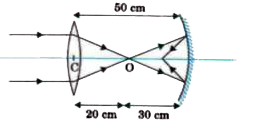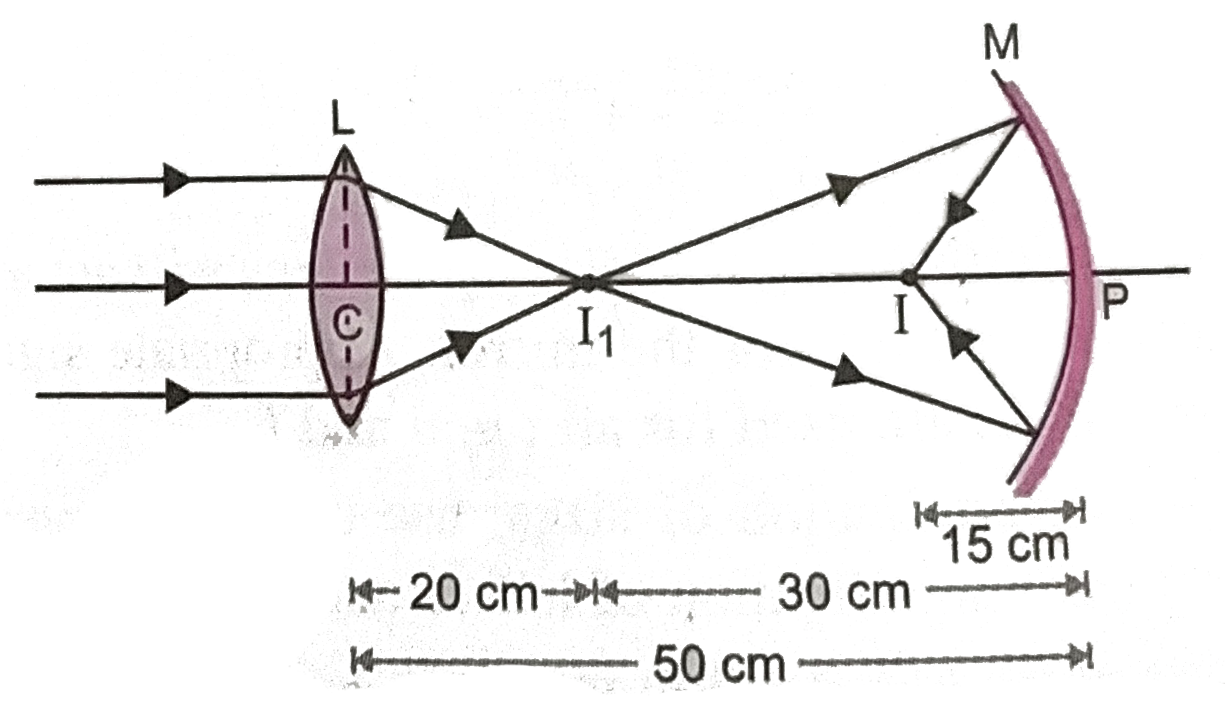A convex lens of focal length and a convex mirror of focal length are placed co-axially apart from each other. An incident beam parallel to its principal axis is incideent on the convex lens. Locate the position of final image formed due to the combination.

The parallel beam of light falling on convex lens will form an image at focus of convex lens, i.e., at 20 cm. This image at O will act as an object for concave mirror.
Thus for concave mirror
The real image will be formed at a distance of 15 cm from concave mirror.
Topper's Solved these Questions
- RAY OPTICS AND OPTICAL INSTRUMENTSBOOK - MODERN PUBLICATIONCHAPTER - RAY OPTICS AND OPTICAL INSTRUMENTSEXERCISE - OBJECTIVE TYPE QUESTIONS (A. MULTIPLE CHOICE QUESTIONS)
40 Videos
- RAY OPTICS AND OPTICAL INSTRUMENTSBOOK - MODERN PUBLICATIONCHAPTER - RAY OPTICS AND OPTICAL INSTRUMENTSEXERCISE - OBJECTIVE TYPE QUESTIONS (B. MULTIPLE CHOICE QUESTIONS)
21 Videos
- RAY OPTICS AND OPTICAL INSTRUMENTSBOOK - MODERN PUBLICATIONCHAPTER - RAY OPTICS AND OPTICAL INSTRUMENTSEXERCISE - Revision Exercises (Long Answer Questions)
20 Videos
- NUCLEIBOOK - MODERN PUBLICATIONCHAPTER - NUCLEIEXERCISE - CHAPTER PRACTICE TEST FOR BOARD EXAMINATION
15 Videos
- SEMICONDUCTOR ELECTRONICS METERIALS DEVICES AND SIMPLE CIRCUITS BOOK - MODERN PUBLICATIONCHAPTER - SEMICONDUCTOR ELECTRONICS METERIALS DEVICES AND SIMPLE CIRCUITS EXERCISE - CHAPTER PRACTICE TEST FOR BOARD EXAMINATION
12 Videos
Similar Questions
A convex lens, of focal length 25 cm, and a concave mirror, of radius of curvature 20 cm. are placed co-axially 4 cm aprat from each other. An incident beam, parallel to the principal axis, is incident on the convex lens. Find the position and nature of the image formed by this combination.
View SolutionA convex lens of focal length 20cm and a convex mirror of focal length 10cm are placed co-axially 50cm apart from each other. An incident on the convex lens. Locate the position of final image formed due to the combination.
 (NCERT Solved Example)
(NCERT Solved Example)
View Solution
Knowledge Check
A convex lens of focal length 10cm and concave lens of focal length 20cm are kept 5cm apart. The focal length of the equivalent lens is
A1203cmB18cmC30cmD403A convex lens of focal length 100 cm and a concave lens of focal length 10 cm are placed coaxialiy at a separation of 90 cm. If a parallel beam of light is incident on convex lens, then after passing through the two lenses the beam
AConvergesBDivergesCRemains parallelDDisappearsA convex lens of focal length 25 cm and a concave lens of focal length 10 cm are joined together. The power of the combination will be
A−16DB+16DC−6DD+6D
A convex lens of focal length 10cm is placed co-axially 5cm away from a concave lens of focal length 10cm. If an object is placed 30cm in front of the convex lens, find the position of final image formed by the combined system.
View SolutionA convex lens of focal length 10 cm is placed coaxially 5 cm away from a concave lens of focal length 10 cm. If an object is placed 30 cm in front of the convex lens, find the position of the final image formed by the combined system.
View SolutionA convex lens of focal length 10 cm is placed coaxially 5 cm away from a concave lens of focal length 10 cm. If an object is placed 30 cm in front of the convex lens, find the position of the final image formed by the combined system.
View SolutionA convex lens of focal length 20cm is placed co-axially with a convex mirrir of radius of curvature 20cm. The two are kept 15cm apart from eachother. A point object is placed 60cm in front of the convex lens. Find the position of the image formed by the combination.
View SolutionA concave lens of focal length 12 cm and a convex lens of focal length 20 cm are kept in contact with each other .
Find the focal length of the combination .
View Solution
